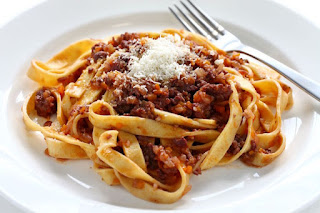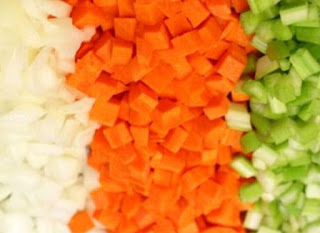 |
| Tagliatelle al ragù |
Origin and History
The first reference to the Bolognese meat-based recipe served with pasta appears in Pellegrino Artusi cookbook published in 1891, two decades after the unification of Italy. Artusi was the first to include recipes from all the different regions of Italy in a single cookbook titled 'La scienza in cucina e l'arte di mangiare bane' ('The Science of Cooking and the Art of Eating Well'). |
| Pellegrino Artusi cookbook |
 |
| Bolognese ragù and its main ingredients |
Though a few things have changed in the modern recipe for the 'ragù alla bolognese', with the addition of white wine, milk and a small amount of tomato puree or concentrate, the most important aspect of the Bolognese ragù is its emphasis on the different meats as the principal ingredient while tomatoes, in one form or another, are only an auxiliary ingredient.
Seasonings are very minimal in Bolognese, as typically only salt and pepper are used.
Traditional Pasta served with Bolognese ragù
In Bologna, ragù alla bolognese is traditionally served with fresh tagliatelle made with eggs and soft wheat flour. Individual pieces of tagliatelle are long, flat ribbons that are similar in shape to fettuccine. |
| Tagliatelle |
Fundamentals of Cooking a Ragù
The fundamentals of cooking a traditional ragù is the preparation of the battuto and soffritto. The soffritto, which comes from the Italian verb, soffrigere, to saute, is the flavor base for many Italian dishes. The battuto, for the preparation of the ragù, usually refers to the raw base of finely chopped vegetables for the soffritto. It comes from the Italian verb battere, to beat / strike, a reference to the chopping of the ingredients on a cutting board. |
| Battuto, for the preparation of the ragù |
Different Variations of the Ragù
The recipe for the preparation of the ragù in other regions of Italy, would mostly differ in the proportion of tomatoes being used, choice and proportion of the meats (pork, beef or veal), choice of the cooking liquids (wine, milk or broth) and the herbs or spices added during cooking. |
| Neapolitan ragù |
Outside Italy, the sauce generally tends to be more tomato-based, with the addition of minced meat (beef or pork).
In many parts of the world, 'spaghetti bolognese' has become a popular dish, though it bears no traditional resemblance with the ragù alla bolognese. People from Bologna often refer to this as a 'crime against ragù'.
References
Italian Cook Book by Pellegrino Artusi
Article Category: Food History




No comments